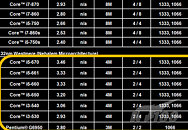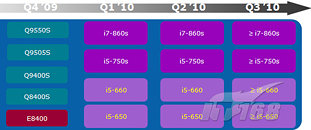- Joined
- Oct 9, 2007
- Messages
- 47,504 (7.49/day)
- Location
- Hyderabad, India
| System Name | RBMK-1000 |
|---|---|
| Processor | AMD Ryzen 7 5700G |
| Motherboard | ASUS ROG Strix B450-E Gaming |
| Cooling | DeepCool Gammax L240 V2 |
| Memory | 2x 8GB G.Skill Sniper X |
| Video Card(s) | Palit GeForce RTX 2080 SUPER GameRock |
| Storage | Western Digital Black NVMe 512GB |
| Display(s) | BenQ 1440p 60 Hz 27-inch |
| Case | Corsair Carbide 100R |
| Audio Device(s) | ASUS SupremeFX S1220A |
| Power Supply | Cooler Master MWE Gold 650W |
| Mouse | ASUS ROG Strix Impact |
| Keyboard | Gamdias Hermes E2 |
| Software | Windows 11 Pro |
Intel is weeks away from letting loose its first socket LGA-1156 processors, starting with a series of quad-core models, namely Core i5 750, Core i7 860, and Core i7 870. According to the latest roadmaps, dual-core derivatives of the Westmere architecture, will arrive in early 2010. IT168 sourced details of the model numbers Intel chalked out, based on roadmap excepts. An older report detailed all six models based on the "Clarkdale" core, including three in the Core i5 series, two in the Core i3 series, and one in the Pentium Dual-Core series. Let's try to make sense of this branding structure.

To begin with, Core i3 series dual-core processors differ from Core i5 in lacking three features: Intel Trusted eXecution Technology (TXT), a set of features that enhance security using hardware-based mechanisms. More on TXT can be read here. The second feature Core i3 lacks is Virtualization Technology for Directed I/O (VT-d), an enhancement to the virtualization capabilities (details here. Core i3 however, does feature VT-x, the regular hardware virtualization features found on today's Intel processors. The third and more relevant feature Core i3 lacks is Turbo Boost technology, a feature that assesses processor load, powers-down one of the two cores, and overclocks the active core, all automatically, and on the fly. This feature holds even more importance in quad-core and multi-socket quad-core machines, but may come handy nonetheless.

Here's what the lineup stands at:
Core i5 models have their model number series beginning in the 600 series, and take off where the 500 series Core i3 processors leave (next to Core i3 530, is Core i5 640). Price-wise, Core i3 dual-core processors tentatively range between US $123~$143, while Core i5 dual-core ones between $176~$284. All these processors feature two cores, and HyperThreading technology enabling four logical CPUs (threads). Each core has a dedicated L2 cache of 256 KB, while a 4 MB L3 cache is shared between two cores.
Finally, Intel's first sub-$100 Pentium dual-core offering based on this architecture will be called Pentium G6950. Clocked at 2.80 GHz, its feature-set is nearly identical to that of the Core i3, except for that it has 3 MB of available L3 cache, and HyperThreading is excluded from the feature-set. All Clarkdale based processors so far, carry TDP rating of 73W.
View at TechPowerUp Main Site

To begin with, Core i3 series dual-core processors differ from Core i5 in lacking three features: Intel Trusted eXecution Technology (TXT), a set of features that enhance security using hardware-based mechanisms. More on TXT can be read here. The second feature Core i3 lacks is Virtualization Technology for Directed I/O (VT-d), an enhancement to the virtualization capabilities (details here. Core i3 however, does feature VT-x, the regular hardware virtualization features found on today's Intel processors. The third and more relevant feature Core i3 lacks is Turbo Boost technology, a feature that assesses processor load, powers-down one of the two cores, and overclocks the active core, all automatically, and on the fly. This feature holds even more importance in quad-core and multi-socket quad-core machines, but may come handy nonetheless.

Here's what the lineup stands at:
- Core i3 530 -2.93 GHz
- Core i3 540 -3.06 GHz
- Core i5 650 -3.20 GHz, with Turbo Boost speed of 3.43 GHz
- Core i5 660 -3.33 GHz, with Turbo Boost speed of 3.60 GHz
- Core i5 670 -3.43 GHz, with Turbo Boost speed of 3.73 GHz
Core i5 models have their model number series beginning in the 600 series, and take off where the 500 series Core i3 processors leave (next to Core i3 530, is Core i5 640). Price-wise, Core i3 dual-core processors tentatively range between US $123~$143, while Core i5 dual-core ones between $176~$284. All these processors feature two cores, and HyperThreading technology enabling four logical CPUs (threads). Each core has a dedicated L2 cache of 256 KB, while a 4 MB L3 cache is shared between two cores.
Finally, Intel's first sub-$100 Pentium dual-core offering based on this architecture will be called Pentium G6950. Clocked at 2.80 GHz, its feature-set is nearly identical to that of the Core i3, except for that it has 3 MB of available L3 cache, and HyperThreading is excluded from the feature-set. All Clarkdale based processors so far, carry TDP rating of 73W.
View at TechPowerUp Main Site





 Wonder what the prices will be on these things.
Wonder what the prices will be on these things.